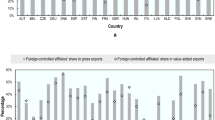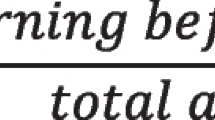Abstract
Both backward (upstream) and forward (downstream) vertical integration strategies shape the organization of global value chains (GVCs). Yet, many studies make the unrealistic assumption that integration decisions are binary and one-directional. That is, for each production stage, companies make the integration decision only once, and this can be either backward or forward but not in both directions. The aim of this paper is to analyze the firm-level organization of GVCs when both vertical integration decisions are taken into account. Exploiting a global sample of more than 1.4 million firms, we first document how midstream parents, which actually integrate on both directions along the chain, are at least as common as downstream and upstream parents. We then find that parent companies prefer to integrate production stages with a relatively low elasticity of substitution and with a technological proximity on the supply chain. Finally, we provide evidence that more than one subsidiary in a given location can perform the same production stage.






Similar content being viewed by others
Notes
MengXiao (2019) finds that, if each industry pair is weighted by its total number of seller-buyer relationships, 62% of the industry pairs feature the coexistence of backward and forward integration.
We follow international standards for the identification of parents and subsidiaries of MNEs (OECD 2005; UNCTAD 2009; UNCTAD 2016), according to which a subsidiary is controlled after a (direct or indirect) concentration of voting rights (> 50%). See also Rungi et al. (2019). Similar data structures have been used in Alviarez et al. (2016), Cravino and Levchenko (2016), and Rungi and Del Prete (2018).
We adopt official correspondence tables from NAICS to 2002 I-O industry codes (IO2002) provided by US Bureau of Ecnomic Analysis.
A key difference with these previous studies is, however, that we also consider output industries. Please note how we make use of primary activities although parents can report several secondary activities different from the primary. In this case, we check that headquarters’ secondary activities can be found as primary activities of the subsidiaries in 99.2% of cases.
The duplication of tasks also exists when we check for’pure’ vertical integration strategies—excluding horizontal integration decisions—for affiliates that report the same downstreamness of the parent. In this case we find that 24% of affiliates perform tasks that are already integrated within the corporate boundary.
In Table 8 in “Appendix”, we show that our results are robust to the implementation of a probit model.
References
Acemoglu, D., Antràs, P., & Helpman, E. (2007). Contracts and technology adoption. American Economic Review, 97(3), 916–943.
Acemoglu, D., Griffith, R., Aghion, P., & Zilibotti, F. (2010). Vertical integration and technology: Theory and evidence. Journal of the European Economic Association, 8(5), 989–1033.
Alfaro, L., & Charlton, A. (2009). Intra-industry foreign direct investment. American Economic Review, 99(5), 2096–2119.
Alfaro, L., Chor, D., Antras, P., & Conconi, P. (2019). Internalizing global value chains: A firm-level analysis. Journal of Political Economy, 127(2), 508–559.
Alfaro, L., Conconi, P., Fadinger, H., & Newman, A. (2016). Do prices determine vertical integration? Review of Economic Studies, 83, 1–35.
Alviarez, V., Cravino, J., & Levchenko, A. A. (2016). The growth of multinational firms in the great recession. Journal of Monetary Economics, 85, 50–64.
Antràs, P. (2003). Firms, contracts, and trade structure. The Quarterly Journal of Economics, 118(4), 1375–1418.
Antràs, P., & Chor, D. (2013). Organizing the global value chain. Econometrica, 81(6), 2127–2204.
Antràs, P., & De Gortari, A. (2020). On the geography of global value chains. Econometrica. Forthcoming.
Antràs, P., & Helpman, E. (2004). Global sourcing. Journal of Political Economy, 112(3), 552–580.
Atalay, E., Hortaçsu, A., Li, M. J., & Syverson, C. (2019). How wide is the firm border? The Quarterly Journal of Economics, 134(4), 1845–1882.
Baker, G. P., & Hubbard, T. N. (2004). Contractibility and asset ownership: On-board computers and governance in US trucking. The Quarterly Journal of Economics, 119(4), 1443–1479.
Bartlett, C. A., & Ghoshal, S. (2000). Going global. Harvard Business Review, 78(2), 132–141.
Broda, C., & Weinstein, D. (2006). Globalization and the gains from variety. Quarterly Journal of Economics, 121(2), 541–585.
Cravino, J., & Levchenko, A. A. (2016). Multinational firms and international business cycle transmission. The Quarterly Journal of Economics, 132(2), 921–962.
Defever, F., & Toubal, F. (2013). Productivity, relationship-specific inputs and the sourcing modes of multinationals. Journal of Economic Behavior & Organization, 94, 345–357.
Del Prete, D., & Rungi, A. (2017). Organizing the global value chain: A firm level test. Journal of International Economics, 109, 16–30. https://doi.org/10.1016/j.jinteco.2017.08.003.
Giroud, X. (2013). Proximity and investment: Evidence from plant-level data. Quarterly Journal of Economics, 128, 861–915.
Grossman, S. J., & Hart, O. D. (1986). The costs and benefits of ownership: A theory of vertical and lateral integration. Journal of Political Economy, 94(4), 691–719.
Hart, O., & Moore, J. (1990). Property rights and the nature of the firm. Journal of Political Economy, 98(6), 1119–1158.
Kalnins, A., & Lafontaine, F. (2004). Multi-unit ownership in franchising: Evidence from the fast-food industry in Texas. RAND Journal of Economics, 35, 747–761.
Kalnins, A., & Lafontaine, F. (2013). Too far away? The effect of distance to headquarters on business establishment performance. American Economic Journal: Microeconomics, 5, 157–179.
Lafontaine, F. (1992). Agency theory and franchising: Some empirical results. RAND Journal of Economics, 23(2), 263–283.
Lafontaine, F., & Shaw, K. L. (1999). The dynamics of franchise contracting: Evidence from panel data. Journal of Political Economy, 107(5), 1041–1080.
Lafontaine, F., & Slade, M. (2007). Vertical integration and firm boundaries: The evidence. Journal of Economic Literature, 45(3), 629–685.
MengXiao, L., (2019). The missing option in firm boundary decisions, mimeo.
Minkler, A. P., & Park, T. A. (1994). Asset specificity and vertical integration in franchising. Review of Industrial Organization, 9(4), 409–423.
Nunn, N. (2007). Relationship-specificity, incomplete contracts, and the pattern of trade. Quarterly Journal of Economics, 122(2), 569–600.
Nunn, N., & Trefler, D. (2013). Incomplete contracts and the boundaries of the multinational firm. Journal of Economic Behavior & Organization, 94, 330–344.
OECD. (2005). Guidelines for Multinational Enterprises. Paris: OECD.
Rauch, J. E. (1999). Networks versus markets in international trade. Journal of International Economics, 48(1), 7–35.
Rungi, A., & Del Prete, D. (2018). The smile curve at the firm level: Where value is added along supply chains. Economics Letters, 164, 38–42.
Rungi, A., Morrison, G., & Pammolli, F. (2019). Global ownership and hierarchies of firms. That which is essential is invisible to the eye, mimeo.
Scott, F. A. (1995). Franchising vs. company ownership as a decision variable of the firm. Review of Industrial Organization, 10(1), 69–81.
UNCTAD. (2009). Training manual on statistics for FDI and the operations of TNCs Vol. II. United Nations.
UNCTAD. (2016). World Investment Report 2016. United Nations.
Woodruff, C. (2002). Non-contractible investments and vertical integration in the Mexican footwear industry. International Journal of Industrial Organization, 20(8), 1197–1224.
Author information
Authors and Affiliations
Corresponding author
Additional information
Publisher's Note
Springer Nature remains neutral with regard to jurisdictional claims in published maps and institutional affiliations.
Rights and permissions
About this article
Cite this article
Del Prete, D., Rungi, A. Backward and Forward Integration Along Global Value Chains. Rev Ind Organ 57, 263–283 (2020). https://doi.org/10.1007/s11151-020-09774-y
Published:
Issue Date:
DOI: https://doi.org/10.1007/s11151-020-09774-y
Keywords
- Global value chains
- Vertical integration
- Property rights theory
- Multinational enterprises
- Downstreamness
- Corporate boundaries




